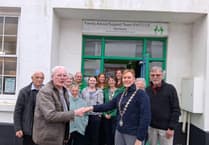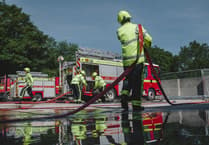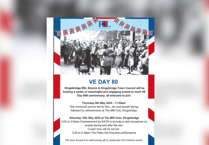Two Falconers in Loddiswell have hit back at claims made by an animal rights organisation over a bird of prey display in Kingsbridge.
Mike and Fi Simmons of MF Falconry, have disagreed with claims made by People for the Ethical Treatment of Animals, PETA, last week that there were “numerous animal-welfare concerns” around having owls in a church.
The letter was sent by PETA to The Rev Jackie Taylor, in response to an event that was planned to take place in St Edmunds Church during Kingsbridge Fair Week.
“What PETA said was right”, said Mike, “IF they had been talking about wild animals, but it is illegal to take birds of prey from the wild, so any bird being used in such a display will have been raised in captivity.”
We met up with Mike and Fi as they were exercising their Barn Owl, Izzy, and their Eurasian Eagle Owl, Archie, who was named when they thought she was a male, because she hoots and only males are supposed to do that.
Both birds are impressive to see up close. Izzy is delicate and stunning to look at, while Archie is just magnificent. Weighing in at around three kilos and with a near six-foot wingspan, she is a wonder to behold. Both were perfectly happy sitting on the glove while we talked.
Mike also disagreed with PETA’s claim that owls are “nocturnal animals”. He said: “Barn owls, like Izzy, have dark eyes, so they prefer to hunt at dawn or dusk, but if they need to hunt, they’ll hunt at any time. Eagle Owls like Archie have light eyes and they’re diurnal [active during the day].”
“We’ve raised these birds since they were 10-days-old” explained Mike. "They’ve imprinted on us and they actually get separation anxiety if they don’t see you. They like the company, they like being stroked - Izzy will fall asleep with Fi stroking her.”
Mike and Fi both talked about the importance of ‘manning’ the birds - handling them and training them, so they can be happy and relaxed in the company of people, and making sure they are calm when they take them to events.
The birds travel is specially-designed travel boxes, known as a ‘giant hood’ because the dark calms the birds like a hood on a hawk, so they’re safe and secure in the vehicle. When they arrive at events, they make sure to arrive hours in advance so the birds can get acclimatised to the environment, hear what’s happening around them, and watch people arrive slowly.
“If any of the birds get even slightly stressed, they go back in their box away from everything” said Fi, “they have water for baths and drinking, they have everything they could want.”
Speaking about The Devon Bird of Prey Centre, who were due to attend St Edmunds Church last week, Mike said: “She’s an excellent falconer who loves her birds”.
Fi also commented on the need for “conservation and education” with all wildlife, and seeing animals up close is often the stepping stone to a life-long love for and protection of wildlife.
There are five native owl species in the UK, the Barn owl, Little owl, Long-eared owl, Short-eared owl and Tawny owl. Little owl numbers are down 24 per cent between 1995-2008 and the Short-eared owl is on the Amber list of endangered animals.
If you find an owl or other bird of prey injured or distressed, contact Mike and Fi on 07706 966198 or email [email protected].





Comments
This article has no comments yet. Be the first to leave a comment.